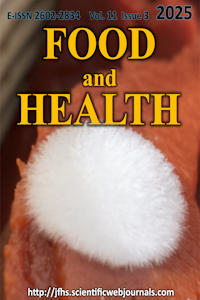Abstract
Project Number
2309-YL-10
References
- Ahmad, S., & Srivastava, P. K. (2007). Quality and shelf life evaluation of fermented sausages of buffalo meat with different levels of heart and fat. Meat Science, 75(4), 603-609. https://doi.org/10.1016/j.meatsci.2006.09.008
- Albayrak, M., & Gunes, E. (2010). Traditional foods: Interaction between local and global foods in Turkey. African Journal of Business Management, 4(4), 555.
- AOAC (1997). Association of Official Analytical Chemists. In W. Horwitz (Eds.) Official methods of analysis (15th ed.). Washington, DC. ISBN: 0-935584-42-0
- Baggio, S.R., & Bragagnolo, N. (2006). The effect of heat treatment on the cholesterol oxides, cholesterol, total lipid and fatty acid contents of processed meat products. Food Chemistry, 95(4), 611-619. https://doi.org/10.1016/j.foodchem.2005.01.037
- Bintsis, T. (2017). Foodborne pathogens. AIMS Microbiology, 3(3), 529. https://doi.org/10.3934/microbiol.2017.3.529
- Bozkurt, H. (2009). The application, mathematical modelling and exergetic optimization of ohmic cooking in kofte production (Doctoral dissertation, M. sc. Thesis, Ege University, Izmir).
- Bragagnolo, N. (2008). Cholesterol and cholesterol oxides in meat and meat products. In Handbook of muscle foods analysis (pp. 207-240). CRC Press. https://doi.org/10.1201/9781420045307.ch12
- Burnham, G.M., Hanson, D.J., Koshick, C.M., & Ingham, S.C. (2008). Death of Salmonella serovars, Escherichia coli O157:H7, Staphylococcus aureus and Listeria monocytogenes during the drying of meat: a case study using biltong and droëwors. Journal of Food Safety, 28(2), 198-209. https://doi.org/10.1111/j.1745-4565.2008.00114.x
- Can, O.P., Şahin, S., Erşan, M., & Harun, F. (2013). Sivas kofte and examination of microbiological quality. Biotechnology in Animal Husbandry, 29(1), 133-143. https://doi.org/10.2298/BAH1301133C
- Chizzolini, R., Zanardi, E., Dorigoni, V., & Ghidini, S. (1999). Calorific value and cholesterol content of normal and low-fat meat and meat products. Trends in Food Science & Technology, 10(4-5), 119-128. https://doi.org/10.1016/S0924-2244(99)00034-5
- Çimen, A., & Çiçek, Ü. (2021). Tokat ilinde satışa sunulan köfte ve dönerlerin bazı fiziksel, kimyasal ve serolojik özellikleri. Gaziosmanpaşa Bilimsel Araştırma Dergisi, 10(2), 71-83.
- Dinh, T.T., Thompson, L.D., Galyean, M.L., Brooks, J.C., Patterson, K.Y., & Boylan, L.M. (2011). Cholesterol content and methods for cholesterol determination in meat and poultry. Comprehensive Reviews in Food Science and Food Safety, 10(5), 269-289. https://doi.org/10.1111/j.1541-4337.2011.00158.x
- Güven, K., Mutlu, M.B., & Avci, O. (2006). Incidence and characterization of Bacillus cereus in meat and meat products consumed in Turkey. Journal of Food Safety, 26(1), 30-40. https://doi.org/10.1111/j.1745-4565.2005.00031.x
- Kadariya, J., Smith, T.C., & Thapaliya, D. (2014). Staphylococcus aureus and staphylococcal food‐borne disease: an ongoing challenge in public health. BioMed Research International, 2014(1), 827965. https://doi.org/10.1155/2014/827965
- Kregel, K.K., Prusa, K.J., & Hughes, K.V. (1986). Cholesterol content and sensory analysis of ground beef as influenced by fat level, heating, and storage. Journal of Food Science, 51(5), 1162-1165. https://doi.org/10.1111/j.1365-2621.1986.tb13073.x
- Lorenzo, J.M., Franco Ruiz, D., & Carballo, J. (2017). Fat content of dry-cured sausages and its effect on chemical, physical, textural and sensory properties. Fermented Meat Products, 1st ed.; Zdolec, N., Ed, 474-487. ISBN: 9781315369846
- Nuray, M., & Oz, F. (2019). The effect of using different types and rates of onion‐water extract in meatball production on the formation of heterocyclic aromatic amines. Journal of the Science of Food and Agriculture, 99(7), 3538-3547. https://doi.org/10.1002/jsfa.9574
- Öğütcü, M., Gevrek, S., & Arifoğlu, N. (2018). Physico‐chemical, textural, microbial and sensory properties of Turkish Tire meatball. Journal of Food Processing and Preservation, 42(10), e13768. https://doi.org/10.1111/jfpp.13768
- Papadima, S.N., Arvanitoyannis, I., Bloukas, J.G., & Fournitzis, G.C. (1999). Chemometric model for describing Greek traditional sausages. Meat science, 51(3), 271-277. https://doi.org/10.1016/S0309-1740(98)00137-5
- Rakha, A., Fatima, M., Bano, Y., Khan, M.A., Chaudhary, N., & Aadil, R.M. (2022). Safety and quality perspective of street vended foods in developing countries. Food Control, 138, 109001. https://doi.org/10.1016/j.foodcont.2022.109001
- Rudel, L.L., & Morris, M.D. (1973). Determination of cholesterol using o-phthalaldehyde. Journal of Lipid Research, 14(3), 364-366. https://doi.org/10.1016/S0022-2275(20)36896-6
- Sarıcaoğlu, F.T., & Turhan, S. (2013). Chemical composition, colour and textural properties of Akcaabat meatball: A traditional Turkish meat product. Gıda, 38(4), 191–198.
- Sunarti, L.S. (2024). Bacterial Contamination in Food: Sources, Risks, and Prevention Strategies. International Journal of Pathogen Research, 13(6), 90-100. https://doi.org/10.9734/ijpr/2024/v13i6324
- Şimşek, A., & Kılıç, B. (2020). Influences of encapsulated polyphosphate incorporation on oxidative stability and quality characteristics of ready to eat beef Döner kebab during storage. Meat Science, 169, 108217. https://doi.org/10.1016/j.meatsci.2020.108217
- Şimşek, A. (2022). An evaluation of the physicochemical and microbiological characteristics and the hygienic status of naturally fermented camel sausages (sucuks). Food Science and Technology, 42, e81321. https://doi.org/10.1590/fst.81321
- Uysal, C., Enişte, İ., Çifçi, M., Şimşek, A., & Kılıç, B. (2022). Effects of different packaging methods and storage temperatures on physicochemical, microbiological, textural and sensorial properties of emulsion-type sausage chips. Journal of Stored Products Research, 98, 102002. https://doi.org/10.1016/j.jspr.2022.102002
- Turkish Patent Institute. (2011). Burdur Şiş Köfte Geographical Indication. Official Gazette, July 3, 2011.
- TFC (2011). Turkish Food Codex, Legislation of Microbiological Criteria. The Official Gazette No:29.12.2011/28157 TFC (2016). Turkish Food Codex, Legislation on Meat and Meat Products. The Official Gazette No, 18, 2016-29774
- Yılmaz, İ., & Dağlıoğlu, O. (2003). The effect of replacing fat with oat bran on fatty acid composition and physicochemical properties of meatballs. Meat Science, 65(2), 819-823. https://doi.org/10.1016/S0309-1740(02)00286-3
- Yilmaz, I., Yetim, H., & Ockerman, H. W. (2002). The effect of different cooking procedures on microbiological and chemical quality characteristics of Tekirdaǧ meatballs. Food/Nahrung, 46(4), 276-278. https://doi.org/10.1002/1521-3803(20020701)46:4<276::AID-FOOD276>3.0.CO;2-2
- Yılmaz, I., & Demirci, M. (1995). A research on determining of the physical, chemical and microbiological properties of Tekirdağ meatball. Journal of Tekirdag Agricultural Faculty, 4(1/2),17-29.
- Yu, S., Yu, P., Wang, J., Li, C., Guo, H., Liu, C., ... & Ding, Y. (2020). A study on prevalence and characterization of Bacillus cereus in ready-to-eat foods in China. Frontiers in Microbiology, 10, 3043. https://doi.org/10.3389/fmicb.2019.03043
Evaluation of the quality and safety of Burdur şiş köfte: Physicochemical and microbiological perspective
Abstract
This research was conducted to evaluate the physicochemical characteristics and microbiological quality of raw and cooked Burdur şiş köfte collected from fast-food restaurants in Burdur, Türkiye. Results for physicochemical properties of raw Burdur şiş köfte samples were 5.84 pH, 58.53% moisture, 16.87% protein, 19.87% fat, 2.99% ash, 2.00% salt and 70.57 mg/100 g cholesterol, whereas, these values for cooked samples were 6.05, 61.85%, 22.88%, 11.10%, 3.13%, 2.11% and 72.65 mg/100 g, respectively. While the average counts (log CFU/g) of total mesophilic aerobic bacteria, total coliforms, yeasts-moulds, Bacillus cereus and Staphylococcus aureus in raw Burdur şiş köfte samples were 5.73, 3.83, 3.09, 2.31 and <1.00, respectively, these counts in cooked Burdur şiş köfte samples were 1.80, <1.00, <1.00, 1.40 and <1.00, respectively. Moreover, Salmonella spp. was not detected in any of the Burdur şiş köfte samples. In conclusion, the present research revealed that the cooked Burdur şiş köfte sold in Burdur had acceptable hygienic quality and nutritional value. On the other hand, some raw Burdur şiş köfte samples were found to have insufficient hygienic quality, which may create a potential health risk to consumers. Therefore, necessary precautions should be taken to ensure hygienic processing, especially during the manufacture of raw Burdur şiş köfte.
Ethical Statement
The authors declare that this study does not involve experiments with human or animal subjects, and therefore, ethics committee approval is not required.
Supporting Institution
This study was supported by Süleyman Demirel University, the Department of Scientific Research Project.
Project Number
2309-YL-10
References
- Ahmad, S., & Srivastava, P. K. (2007). Quality and shelf life evaluation of fermented sausages of buffalo meat with different levels of heart and fat. Meat Science, 75(4), 603-609. https://doi.org/10.1016/j.meatsci.2006.09.008
- Albayrak, M., & Gunes, E. (2010). Traditional foods: Interaction between local and global foods in Turkey. African Journal of Business Management, 4(4), 555.
- AOAC (1997). Association of Official Analytical Chemists. In W. Horwitz (Eds.) Official methods of analysis (15th ed.). Washington, DC. ISBN: 0-935584-42-0
- Baggio, S.R., & Bragagnolo, N. (2006). The effect of heat treatment on the cholesterol oxides, cholesterol, total lipid and fatty acid contents of processed meat products. Food Chemistry, 95(4), 611-619. https://doi.org/10.1016/j.foodchem.2005.01.037
- Bintsis, T. (2017). Foodborne pathogens. AIMS Microbiology, 3(3), 529. https://doi.org/10.3934/microbiol.2017.3.529
- Bozkurt, H. (2009). The application, mathematical modelling and exergetic optimization of ohmic cooking in kofte production (Doctoral dissertation, M. sc. Thesis, Ege University, Izmir).
- Bragagnolo, N. (2008). Cholesterol and cholesterol oxides in meat and meat products. In Handbook of muscle foods analysis (pp. 207-240). CRC Press. https://doi.org/10.1201/9781420045307.ch12
- Burnham, G.M., Hanson, D.J., Koshick, C.M., & Ingham, S.C. (2008). Death of Salmonella serovars, Escherichia coli O157:H7, Staphylococcus aureus and Listeria monocytogenes during the drying of meat: a case study using biltong and droëwors. Journal of Food Safety, 28(2), 198-209. https://doi.org/10.1111/j.1745-4565.2008.00114.x
- Can, O.P., Şahin, S., Erşan, M., & Harun, F. (2013). Sivas kofte and examination of microbiological quality. Biotechnology in Animal Husbandry, 29(1), 133-143. https://doi.org/10.2298/BAH1301133C
- Chizzolini, R., Zanardi, E., Dorigoni, V., & Ghidini, S. (1999). Calorific value and cholesterol content of normal and low-fat meat and meat products. Trends in Food Science & Technology, 10(4-5), 119-128. https://doi.org/10.1016/S0924-2244(99)00034-5
- Çimen, A., & Çiçek, Ü. (2021). Tokat ilinde satışa sunulan köfte ve dönerlerin bazı fiziksel, kimyasal ve serolojik özellikleri. Gaziosmanpaşa Bilimsel Araştırma Dergisi, 10(2), 71-83.
- Dinh, T.T., Thompson, L.D., Galyean, M.L., Brooks, J.C., Patterson, K.Y., & Boylan, L.M. (2011). Cholesterol content and methods for cholesterol determination in meat and poultry. Comprehensive Reviews in Food Science and Food Safety, 10(5), 269-289. https://doi.org/10.1111/j.1541-4337.2011.00158.x
- Güven, K., Mutlu, M.B., & Avci, O. (2006). Incidence and characterization of Bacillus cereus in meat and meat products consumed in Turkey. Journal of Food Safety, 26(1), 30-40. https://doi.org/10.1111/j.1745-4565.2005.00031.x
- Kadariya, J., Smith, T.C., & Thapaliya, D. (2014). Staphylococcus aureus and staphylococcal food‐borne disease: an ongoing challenge in public health. BioMed Research International, 2014(1), 827965. https://doi.org/10.1155/2014/827965
- Kregel, K.K., Prusa, K.J., & Hughes, K.V. (1986). Cholesterol content and sensory analysis of ground beef as influenced by fat level, heating, and storage. Journal of Food Science, 51(5), 1162-1165. https://doi.org/10.1111/j.1365-2621.1986.tb13073.x
- Lorenzo, J.M., Franco Ruiz, D., & Carballo, J. (2017). Fat content of dry-cured sausages and its effect on chemical, physical, textural and sensory properties. Fermented Meat Products, 1st ed.; Zdolec, N., Ed, 474-487. ISBN: 9781315369846
- Nuray, M., & Oz, F. (2019). The effect of using different types and rates of onion‐water extract in meatball production on the formation of heterocyclic aromatic amines. Journal of the Science of Food and Agriculture, 99(7), 3538-3547. https://doi.org/10.1002/jsfa.9574
- Öğütcü, M., Gevrek, S., & Arifoğlu, N. (2018). Physico‐chemical, textural, microbial and sensory properties of Turkish Tire meatball. Journal of Food Processing and Preservation, 42(10), e13768. https://doi.org/10.1111/jfpp.13768
- Papadima, S.N., Arvanitoyannis, I., Bloukas, J.G., & Fournitzis, G.C. (1999). Chemometric model for describing Greek traditional sausages. Meat science, 51(3), 271-277. https://doi.org/10.1016/S0309-1740(98)00137-5
- Rakha, A., Fatima, M., Bano, Y., Khan, M.A., Chaudhary, N., & Aadil, R.M. (2022). Safety and quality perspective of street vended foods in developing countries. Food Control, 138, 109001. https://doi.org/10.1016/j.foodcont.2022.109001
- Rudel, L.L., & Morris, M.D. (1973). Determination of cholesterol using o-phthalaldehyde. Journal of Lipid Research, 14(3), 364-366. https://doi.org/10.1016/S0022-2275(20)36896-6
- Sarıcaoğlu, F.T., & Turhan, S. (2013). Chemical composition, colour and textural properties of Akcaabat meatball: A traditional Turkish meat product. Gıda, 38(4), 191–198.
- Sunarti, L.S. (2024). Bacterial Contamination in Food: Sources, Risks, and Prevention Strategies. International Journal of Pathogen Research, 13(6), 90-100. https://doi.org/10.9734/ijpr/2024/v13i6324
- Şimşek, A., & Kılıç, B. (2020). Influences of encapsulated polyphosphate incorporation on oxidative stability and quality characteristics of ready to eat beef Döner kebab during storage. Meat Science, 169, 108217. https://doi.org/10.1016/j.meatsci.2020.108217
- Şimşek, A. (2022). An evaluation of the physicochemical and microbiological characteristics and the hygienic status of naturally fermented camel sausages (sucuks). Food Science and Technology, 42, e81321. https://doi.org/10.1590/fst.81321
- Uysal, C., Enişte, İ., Çifçi, M., Şimşek, A., & Kılıç, B. (2022). Effects of different packaging methods and storage temperatures on physicochemical, microbiological, textural and sensorial properties of emulsion-type sausage chips. Journal of Stored Products Research, 98, 102002. https://doi.org/10.1016/j.jspr.2022.102002
- Turkish Patent Institute. (2011). Burdur Şiş Köfte Geographical Indication. Official Gazette, July 3, 2011.
- TFC (2011). Turkish Food Codex, Legislation of Microbiological Criteria. The Official Gazette No:29.12.2011/28157 TFC (2016). Turkish Food Codex, Legislation on Meat and Meat Products. The Official Gazette No, 18, 2016-29774
- Yılmaz, İ., & Dağlıoğlu, O. (2003). The effect of replacing fat with oat bran on fatty acid composition and physicochemical properties of meatballs. Meat Science, 65(2), 819-823. https://doi.org/10.1016/S0309-1740(02)00286-3
- Yilmaz, I., Yetim, H., & Ockerman, H. W. (2002). The effect of different cooking procedures on microbiological and chemical quality characteristics of Tekirdaǧ meatballs. Food/Nahrung, 46(4), 276-278. https://doi.org/10.1002/1521-3803(20020701)46:4<276::AID-FOOD276>3.0.CO;2-2
- Yılmaz, I., & Demirci, M. (1995). A research on determining of the physical, chemical and microbiological properties of Tekirdağ meatball. Journal of Tekirdag Agricultural Faculty, 4(1/2),17-29.
- Yu, S., Yu, P., Wang, J., Li, C., Guo, H., Liu, C., ... & Ding, Y. (2020). A study on prevalence and characterization of Bacillus cereus in ready-to-eat foods in China. Frontiers in Microbiology, 10, 3043. https://doi.org/10.3389/fmicb.2019.03043
Details
| Primary Language | English |
|---|---|
| Subjects | Meat Technology, Food Microbiology, Food Technology |
| Journal Section | Research Article |
| Authors | |
| Project Number | 2309-YL-10 |
| Early Pub Date | June 13, 2025 |
| Publication Date | July 1, 2025 |
| Submission Date | February 18, 2025 |
| Acceptance Date | March 23, 2025 |
| Published in Issue | Year 2025 Volume: 11 Issue: 3 |
Journal is licensed under a
CreativeCommons Attribtion-ShareAlike 4.0 International Licence 


Diamond Open Access refers to a scholarly publication model in which journals and platforms do not charge fees to either authors or readers.
Open Access Statement:
This is an open access journal which means that all content is freely available without charge to the user or his/her institution. Users are allowed to read, download, copy, distribute, print, search, or link to the full texts of the articles, or use them for any other lawful purpose, without asking prior permission from the publisher or the author. This is in accordance with the BOAI definition of open access.
Archiving Policy:
Archiving is done according to ULAKBİM "DergiPark" publication policy (LOCKSS).

